|
The First Railway in Ottawa
The first railway train entered what is now known as the city of Ottawa 150 years ago in December 1854. With the dawn of 1855, Bytown became the city of Ottawa. About that time, wherever people met one question sure to be asked was "Have you seen the cars yet?" Part of the line is still in operation today and many thousands use it daily. Bytown was a vastly different place from the city we know today. It was a small lumber town surrounded by dense, almost impenetrable, bush and water transport was the most readily available. The Ottawa River, in spite of its many rapids, provided transport for both passengers and freight to Montreal, and the Rideau Canal gave access to the St. Lawrence at Kingston. Of course this mode of transport was not available in the winter when horse drawn sleighs had to be used over very rough tracks. In 1848, a group of Bytown business men decided they needed better communication with the outside world.[1] A network of railways was beginning to develop in the United States and there were plans for a line to Ogdensburgh, NY, and so the people of Bytown sought to build a line to Prescott where a ferry across the St. Lawrence River would give them access year round to the outside world, including Montreal. The Bytown and Prescott Railway was formed in 1850 and started looking for funds.[2] Subscriptions for stock were slow in coming but by the end of that year Bytown, Prescott and several smaller communities had pledged to give a bonus to the railway when it completed its line. This was, of course, very controversial because the bonus was funded from local taxes. The next step was to survey a route and this was done by Walter Shanly, the distinguished civil engineer who would eventually become a Member of Parliament and would exercise considerable influence in nineteenth century railway matters. In these days of GPS satellite systems it is difficult to imagine how surveys were carried out 150 years ago. Because of the dense swamp, the only practicable time of year to survey was when the snow was on the ground. With but two assistants, Shanly surveyed the route on snowshoes during March 1851. At night, he slept out in the open or sheltered in the small hamlets along the route. He surveyed three routes which means that, in effect, he walked on snowshoes between Bytown and Prescott three times.[3] The choice of a Bytown terminus caused some comment. Thomas McKay was a prominent Bytown businessman who owned extensive mills at the Rideau Falls. He was also a member of the Legislative Council of Canada and was able to ensure that the terminus would be close to his mills rather than at the Chaudiere (Lebreton Flats). In September 1851 the tender of Messrs. French & Co. for clearing and grubbing of the woodland upon the whole line was accepted and Chief Engineer Shanly had already advertised for certain sections of the grading.[4] On 9th November 1851 there was a celebration which was attended by all the important people of Bytown, the Sons of Temperance being prominent. The procession route was from Rideau to Sussex and from there to Boteler, near where the Saudi embassy now stands. At that time, the city potholed streets were either wet and muddy or dry and dusty. It was quite likely that a small boy was delegated to run ahead and ensure that wandering cows and pigs were cleared out of the way of this august gathering. There was a ceremonial turning of the first sod by the President Mr. Robert Bell and then the august company sat down to a fine dinner at Doran’s. There were, of course many speeches, toasts and songs.[5] The ceremony created a great deal of interest locally and the Bytown Packet, for its 1st January 1852 issue, published an artist’s drawing of the bridge which would be built across the Rideau River near Green Island. This was part of a salute to the newspaper boys who were a vital part of the paper’s distribution. The Bytown Packet was a forerunner of the present day Ottawa Citizen and its proprietor, Robert Bell, the secretary of the company, played a significant role in completing the line. 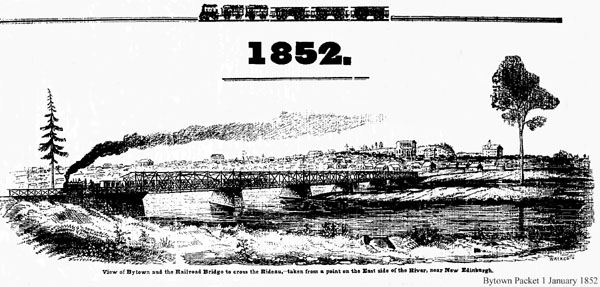
In 1852, the company acquired land, ordered materials and started to clear the grade but it was slow work and much remained to be done by the end of 1853, although half of the rails had arrived in the fall. The land had to be cleared by hand, the only assistance being horse drawn carts. Many of the low areas were crossed with wooden trestles which were filled in with earth a few years later. 1854 dawned with very little to show other than the prepared grade waiting for the rails, the second half of the rails arriving in the spring. There was unexpected action with the railway sending out a gang of men to cut down telegraph poles that had been placed on the cleared right of way by the Grand Trunk Telegraph Company. It appears there was a misunderstanding – the telegraph company claiming it had permission and the railway strenuously denying this.[6] In the event, after the poles had been removed they must have been replaced in good order because the telegraph was in operation by the time the railway reached Ottawa.[7] Things were looking brighter when on April 24th 1854 the laying of rails was started in the Prescott yard[8] and on the main line out of Prescott in early May.[9] These rails were to give good service as they were not replaced until the summer of 1881.[10] Spirits were lifted high on May 13th, 1854 when the Ottawa Citizen ran a story from the Ogdensburg Republican of May 9th, under the headline “Heads Up.” “The first locomotive for the Bytown and Prescott Railway company arrived at the depot in this village (i.e. Ogdensburg) last evening. The name of this locomotive is the "Oxford", and it was manufactured at the "Boston Locomotive Works" of Hinckley and Drury. It is a beautiful piece of workmanship and we long to see it hitched on to a train of cars, steaming and whistling away between Ottawa and the St. Lawrence.”The “Oxford” was brought across the St. Lawrence on 19th May[11] along with a number of gravel and lumber cars. This carried road number 1 and was an 0-4-0 switching locomotive from the Boston Locomotive Works (also known as Hinkley and Drury), construction number 515. That same evening, day the Engineers and Contractors met at Gilman's Hotel, in Prescott, for the purpose of presenting to Walter Shanly, Esq., the late Chief Engineer of the road, several pieces of plate, as a testimonial to their esteem for him.[12] The Ottawa Citizen said it would not be long before “we shall have the iron coursers snorting and pawing the Bytown”. With work trains running north from Prescott there was great pressure to go for a ride on this novel and modern form of transport. Many people, especially the small boys, took unofficial trips on the work trains, but the first official passenger trip took place on June 21st. It was advertised in the Prescott Telegraph.[13] “First passage per Bytown and Prescott Railway.
“We are requested to state that the Prescott Division of the "Sons" have engaged passages by the cars to attend the Temperance Celebration at Spencerville on Wednesday next the 21st inst., and other individuals can also be accommodated at the same price, say Three York Shillings each for going and returning.On 8th July, two additional locomotives, No. 2, “St. Lawrence” and No. 3 “Ottawa”, together with several gravel cars, were brought over the river and placed upon the track at Prescott.[14] These 4-4-0’s were also from Boston, construction numbers 526 and 525 respectively. They had 54-inch driving wheels and 14 x 22-inch cylinders, and were regarded as freight locomotives. 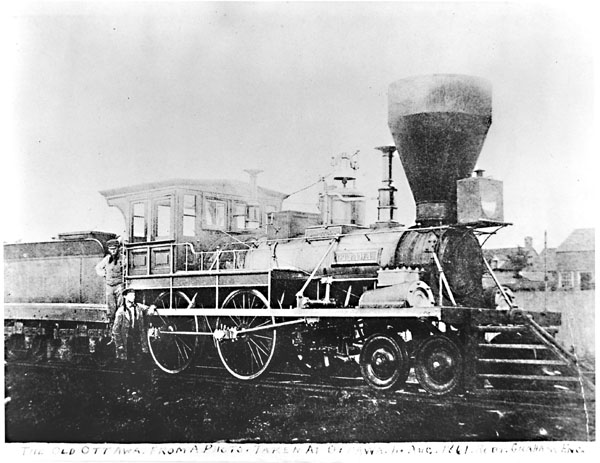
To sample the cars, Bytonians had to travel to Kemptville, regular service having commenced between there and Prescott in early August. However, to get to Kemptville was not straightforward although it did make for an interesting day out as explained by a gentleman writing under the nom de plume of Bullfrog.[15] “Bytown August 10.It was a long day, but participants could proudly boast to their less adventurous friends that they had seen and ridden the cars. Riding the cars must have been quite an experience, as the following account of a temperance excursion the same month illustrates: [16] “Having a partial regard to public prosperity and the cause of temperance, we appropriated the day and made one of the multitude. At the depot at Prescott, we found the locomotive “St. Lawrence” most gaudily dressed in holiday clothes, trimmed with flowers, evergreens and flags. The stars and stripes, on equal footing with the cross of St. George, floating on either side of engine and tender. Three passenger and three platform cars, capable of carrying over one hundred passengers each constituted the train. We left Prescott 9.36 a.m. with all the cars comfortably filled, having on board delegations from Ogdensburgh, Brockville, Maitland, Augusta and a general turnout from Prescott. At most of the cross-roads, we passed large crowds anxious to arrest the train that they might procure passage, but it was impossible to accommodate them. At Spencer's we were joined by a delegation of about two hundred who were "piled on". Seating or stowing them away, was a question not to be entertained, not less debated. The cars, we presume, if they could have told their feelings, would have made the same reply that the notorious Charles Lamb did, when the inquisitive cab man thrust his head into the box and asked "Are you full in there?" The reply was "I don't know how it is with the other passengers, but that last piece of pie did the thing up for me!" So it was with the cars, that last station, had most emphatically done the thing up for them. Just imagine an old fashioned four seat stage coach, with four passengers on each seat, two standing between seats and a fat old lady and gent entering thro' the door, on either side, and you have a tolerable fair idea of our compactness after absorbing that last two hundred. Being somewhere in the vicinity of the middle of one of the platform cars, and near the bottom of the pile, we knew or saw little else during the remainder of the passage. We know however that there was enjoyment and sport among the top tier for often we felt the pile shake as though the outside ones were laughing, and a spent voice reached us with the exclamation "there goes another hat!" which was all explained when we reached Kemptville, by seeing a number of individuals with their heads dressed in handkerchiefs.”Even as early as August, the potential arrival of the railway in Ottawa had triggered increased economic activity. The Ottawa Citizen reported on 6th August “We understand that an arrangement is about to be effected between Mr. Forsyth (of Pittsburgh who is looking at iron ore in Hull township) and the Bytown and Prescott Railway for the transport of the ore. This will add immensely to the profits of the road. In the meantime, a large party of miners have arrived and commenced operations.”From the end of August, people in Bytown travelled to Prescott by steamer on the Rideau Canal to Beckett’s Landing thence by stagecoach to the railway station in Kemptville. Regular trains began running between Prescott and Kemptville on 9th September.[17] The rail gangs moved relentlessly forward during September and October so that, by 4th November, trains were running as far as Gloucester with a stage coach connection to Bytown[18]. Excitement reached fever pitch on 11th November when, for the first time, the locomotive steam whistle could clearly be heard in Bytown.[19] The locomotive reached Billings saw mill on 2nd December.[20] By 16th December, trains were running to the crossing with the Montreal Road and transport to town was provided by horse drawn cabs (sleighs).[21] However, the bridge over the Rideau River was not quite ready for the opening of the line to Bytown and the terminus remained at Montreal Road until late December 1854 or early January 1855. Robert Bell, the president, speaking on 22nd August 1862, said “…On 29th December we brought the first engine through and formed our first train…”[22] 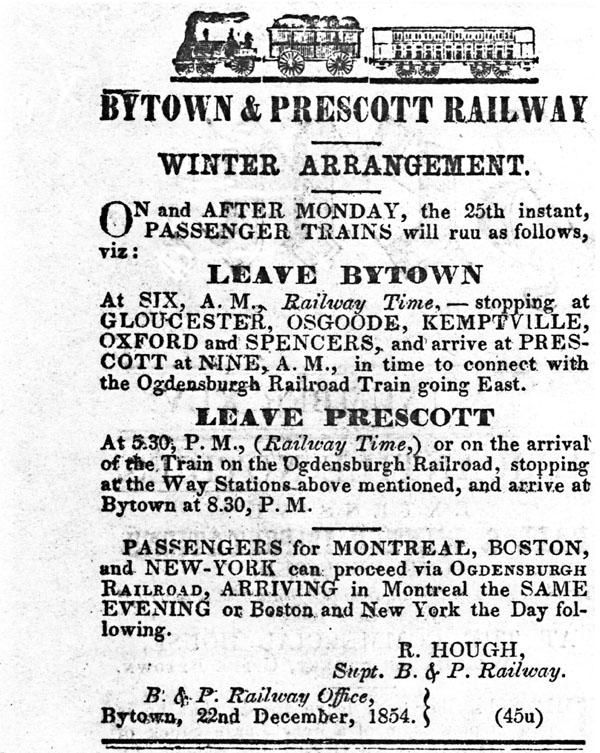
Despite evidence to the contrary, persistent oral tradition claims that St. Lawrence powered the first work train into Bytown on Christmas Day 1854, with Robert Graham as engineer and Mike Mahar as fireman. Equally persistent tradition claims that Ottawa brought in the first passengers on that day. 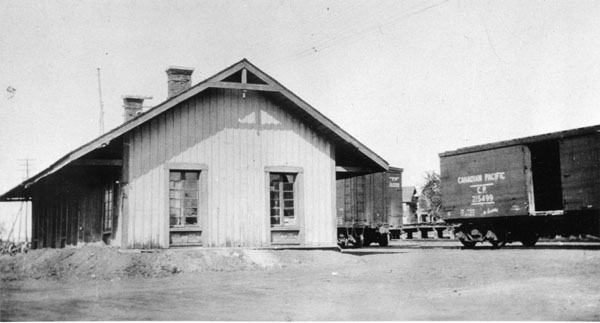
The original station at Sussex Street burnt down in May 1860 and there was another fire in July 1895. This photo was likely taken in the 1940’s.Much has been written in an attempt to dramatize the event, but the fact remains that the railway opened into Bytown without ceremony. It is best left to an eye witness writing in the Ottawa Journal on 12th December 1895: “On Christmas day, 1854, the writer, accompanied by some young people went to the east side of the Rideau at 8.45 p.m. the hour when the train from Prescott was due. All were eager to get a glimpse of the railway train. It was a dark night. There was no gas in the town at that time. The Rideau river and the Montreal road looked dismal enough. Soon the whistle of a locomotive was heard in the distance. It was pleasant to see a train of brightly lighted cars come slowly along the track. They stopped on the north side of Montreal road. A few passengers got off and were conveyed into town in cabs.”And so the Bytown and Prescott Railway, whose name was quickly changed to Ottawa and Prescott Railway, was opened for business. One early source of revenue was the material for the parliament buildings. A special train made a round trip each day for three years. The stone used in the building came from quarries at Cleveland, Ohio. It was shipped to Prescott where it was loaded from the boats on to railway cars by large cranes. Stones weighing from two to nine tons were moved into Ottawa on flat cars that were hardly up to such weights. You can still see the remains of the four piers of the bridge across the Rideau River just upstream from Green Island, one of them only being visible when the water is very low. At this location there is a stone arch on the west bank of the river but the rest of the original station area has been obliterated by roads and the External Affairs building. The Vanier Parkway is built on the route of the Bytown and Prescott Railway but, better still, take a ride on the O Train. The first kilometer or so of the line north from Greenboro station is over the original route after which it branches north westwards on a section of line which was built in 1871. The railway has had a checkered career in Ottawa in the subsequent one hundred and fifty years, but for the present, let us just celebrate it. To the Bytown and Prescott Railway we say “Happy One Hundred and Fiftieth Birthday”. 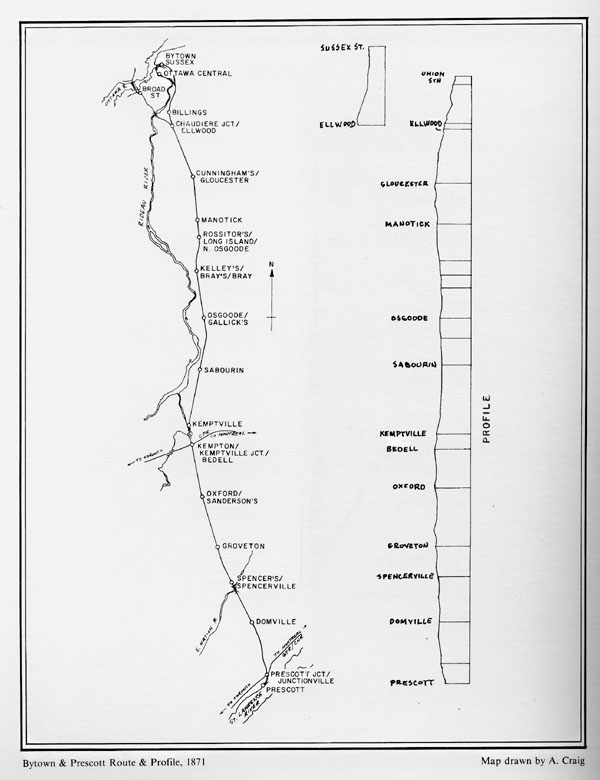
This is a route map and profile of the Bytown and Prescott Railway drawn by Al Craig and used in the Bytown Railway Society publication on the line published in 1979. Sources in addition to those shown in the footnotes:
- The Bytown and Prescott Railway 1854 – 1879 by S.R. Elliot, published by the Bytown Railway Society 1979. Footnotes
Bytown Railway Society, Branchline, February 2005. |
![]()